Petra in Jordan
Petra, known as the “Rose City” because of the beautiful pink color of its rocks, is an incredible historical site in southwestern Jordan, close to a town called Wadi Musa. It’s recognized as one of the World’s New Seven Wonders. Once upon a time, Petra was the vibrant center of the Nabataean civilization and played an important role in trade, connecting regions like Arabia, Egypt, and Syria-Phoenicia.
This captivating city combines stunning natural landscapes with remarkable human creations. It boasts impressive structures, some carved right into the rock and others built using traditional methods. The city’s remarkable tombs, temples, and water systems displayed the advanced skills and ingenuity of the Nabataeans, who once thrived here.
Petra, acknowledged as a UNESCO World Heritage Site, is famous for its stunning buildings and vibrant history. It showcases a blend of Eastern traditions and Greek influences. As visitors walk through its narrow paths, especially the Siq, they are taken back to a time when Petra was a lively hub for trade and cultural interaction. This fascinating place has attracted explorers and tourists for many years.
Table of Contents
Where is the location of Petra?
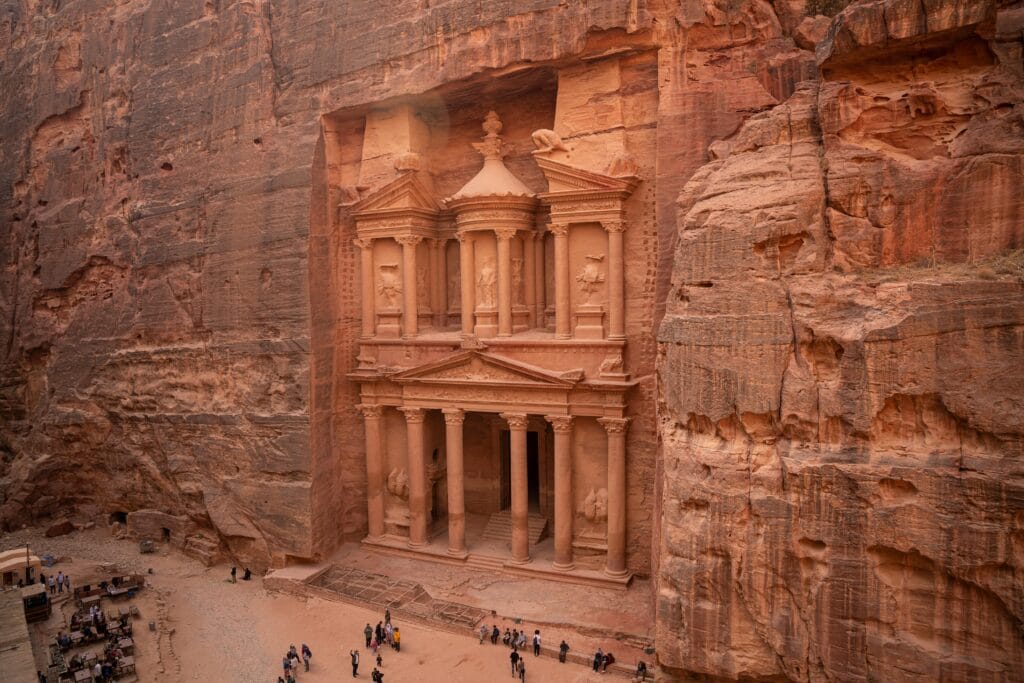
Petra is an ancient city situated in southwest Jordan, close to a place called Wadi Musa. It used to be the capital of a group of people known as the Nabataeans. The city is nestled in a valley that is surrounded by mountains and stretches from the Dead Sea to the Gulf of Aqaba. Today, Petra is famous for its incredible historical significance and stunning architecture and is recognized as a UNESCO World Heritage Site. It is also celebrated as one of the World’s New Seven Wonders.
Inscription
Petra was recognized as a UNESCO Heritage Site in 1985 and was proudly added to the list of the World’s New Seven Wonders in 2007. The importance of Petra comes from its incredible buildings and its history as a lively center for trade and cultural exchange. It was a place where different cultures came together, making it truly special.
What is the meaning of Petra?
Petra is a fascinating ancient city whose name means “rock” in Greek, which makes sense because it’s known for its incredible buildings that were carved right out of the cliffs. Many people call it “the Rose City” because of the beautiful pinkish stone used in its structures. Petra is an important historical site, showcasing a mix of different cultures and architectural styles from the past.
What is the history of Petra?

Petra has a fascinating and layered history that goes back to about the 4th century BCE. Petra, a remarkable ancient city, acted as an important meeting point connecting Arabia, Egypt, and Syria-Phoenicia. It was first home to the Nabataeans, a nomadic Arab tribe. They settled in the area and turned Petra into an important center for trade because of its prime location between Arabia, Egypt, and the Mediterranean Sea. This strategic position allowed it to flourish as a bustling marketplace.
At its height, especially in the 1st century BCE and the 1st century CE, Petra was a vibrant hub for trade, drawing in merchants and travelers from far and wide. The Nabataeans, who lived there, created clever systems to manage water, which helped them survive and flourish in the dry desert. They also carved stunning buildings right into the cliffs, combining styles from the East and the Hellenistic world, resulting in a unique architecture that still impresses visitors today.
Petra joined the Roman Empire in 106 CE, which helped it grow and thrive. However, as trade started happening more through sea routes, Petra began to decline around the 3rd century CE. By the early Middle Ages, it had become mostly forgotten and wasn’t well known to people outside the region. It wasn’t until the early 19th century that explorers rediscovered this remarkable city.
Today, Petra is known as a UNESCO World Heritage Site, which means it’s recognized for its incredible historical and cultural importance. People from all over the world come to see its amazing archaeological treasures and to appreciate its rich history.
Who discovered Petra?
In 1812, a Swiss traveler named Johann Ludwig Burckhardt found the ancient city of Petra, which had been overlooked for many years. His exploration sparked new interest in this incredible place, which is rich in history and archaeology. Burckhardt’s stories about his journey helped to highlight Petra’s historical and archaeological significance.
Who is the Nabateans?

The Nabateans were an ancient Arab group known for their impressive trade routes and their skill in surviving in the challenging desert conditions of modern-day Jordan, Saudi Arabia, and nearby regions. They are most famous for the city of Petra, which is well-known for its beautiful buildings carved into rock and its clever systems for transporting water.
What is the history of Nabateans?
The Nabateans appeared around the 4th century BCE and became important traders, controlling vital trade routes that linked Arabia, Egypt, and the Mediterranean Sea. During ancient times, especially in the Hellenistic and Roman periods, it became a key stop for traders who brought valuable goods like Arabian incense, Chinese silks, and Indian spices. This city was an important meeting place for people from Arabia, Egypt, and the region of Syria-Phoenicia.
Architecture and Archaeological Site of Petra
Petra showcases how ancient Eastern traditions blend with Greek-style buildings, highlighting its history as a lively center for cultural exchange. Petra is a historic site built partially by hand and partially carved into rock. It is surrounded by mountains with many paths and valleys. Petra is important because of its complex tombs and temples. It has sites for religious ceremonies, water channels, tunnels, diversion dams, and large cisterns that collect and store rainwater. There are also many archaeological remains, including copper mines, temples, churches, and other public buildings.
The architectural group called the “royal tombs” in Petra includes the Khasneh, Urn Tomb, Palace Tomb, Corinthian Tomb, and Deir (“monastery”). These structures show a unique mix of Hellenistic style and Eastern tradition. They highlight the blending of East and West around the start of the first millennium. The copper mines and underground galleries at Umm al Amad are impressive mining sites that date back to the fourth millennium BC.
Petra is famous around the world for its importance in archaeology. The archaeological remains and buildings from prehistoric to medieval times offer important evidence of the lost civilizations that lived in this area. Petra is one of the world’s most significant and rich archaeological sites, set against a stunning red sandstone backdrop.
Artistic Achievement
The mix of Hellenistic architectural styles with traditional Nabataean rock-cut temples and tombs shows impressive artistic skill. Notable structures include the Khasneh, the Urn Tomb, the Palace Tomb, the Corinthian Tomb, and the Deir (Monastery). These buildings, made between the first centuries BC and AD, highlight an exceptional collection of architecture. Their design and location emphasize their outstanding universal value.
The rock-carved temples and tombs of the Nabataean and Hellenistic people are set in a stunning landscape. Visitors can reach these impressive structures through a natural winding path called the Siq. These sites mark the entrance to a once-large trading city. They showcase remarkable artistic skill and have attracted tourists since the early 1800s.
Civilization of Petra
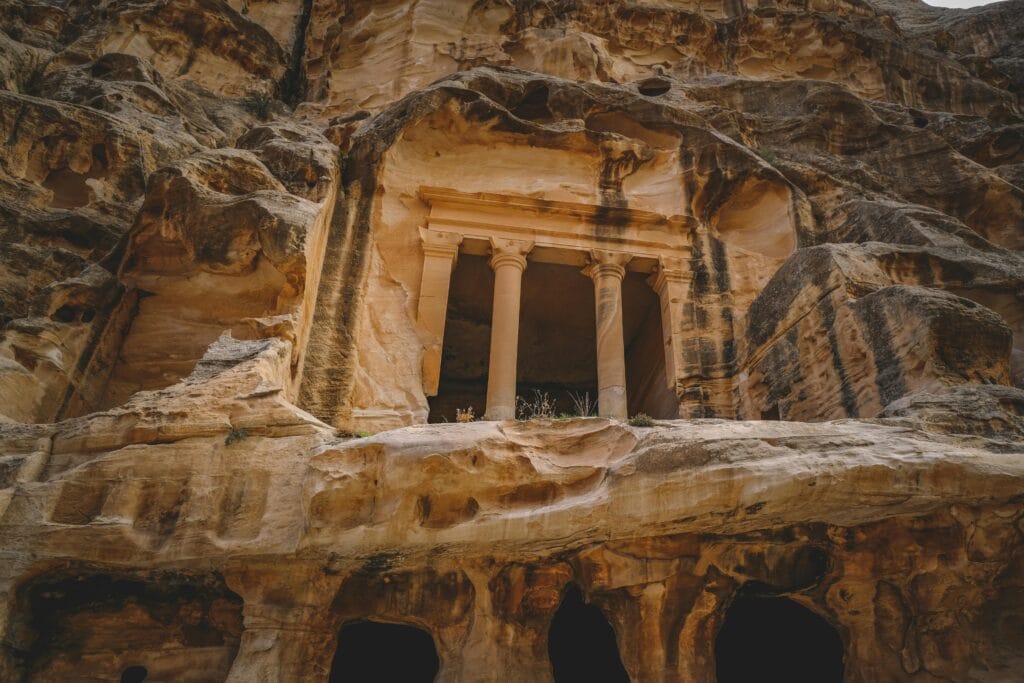
The ancient site of Beidha, which dates back to the Neolithic period, along with the Iron Age settlement at Umm al Biyara and the mining areas from the Chalcolithic period at Umm al Amad, provide insight into how people lived in earlier times. Additionally, the architectural features from the Graeco-Roman era include things like a wide street lined with columns, a grand entrance with three arches, a theater for performances, a decorative fountain area known as a Nymphaeum, and public baths, all showcasing the community’s way of life during that period.
There are also Byzantine structures like the triple-apses basilica church and the church in the Urn Tomb. Remnants of Crusader fortresses, Habis and Wueira, can still be seen. Lastly, there is a mosque on Jebel Haroun, which is traditionally known as the burial place of the Prophet Aaron. All these sites provide important evidence of the past civilizations in the Petra area.
Many tombs carved into rock are closely packed together, showcasing styles from the Assyrians to the grand Hellenistic period. These tombs are an impressive reminder of the Nabataean civilization, which thrived from the 4th century BC to the 1st century AD.
Water Engineering System
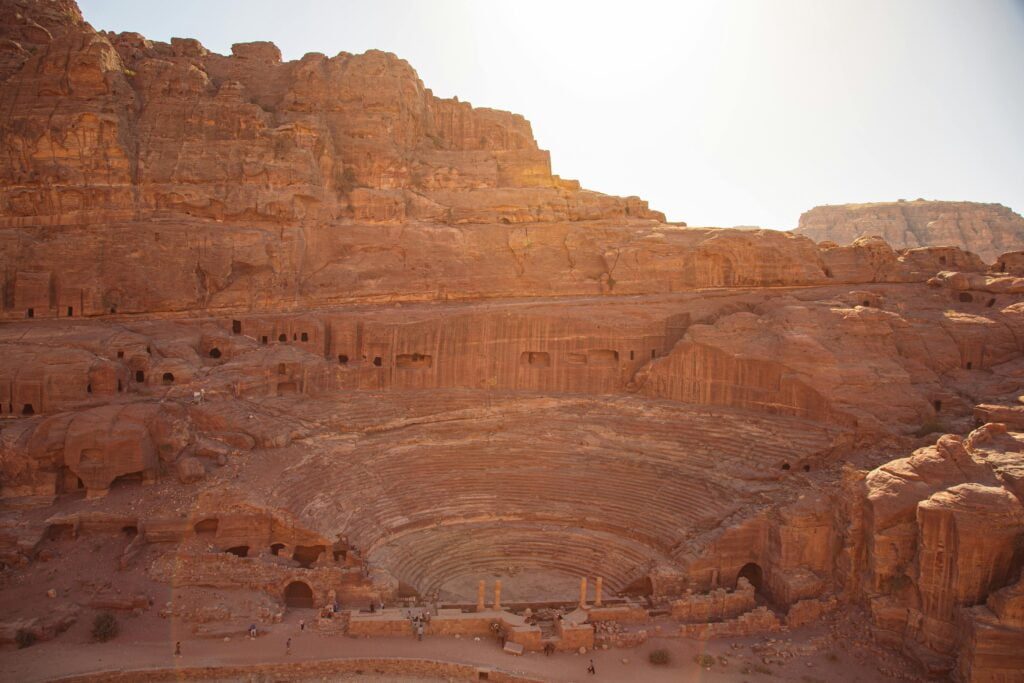
In Petra, the stopping points for caravans traveling from the north (like Barid or Little Petra) and the south (like Sabra) include various important structures like tombs, temples, and systems for collecting and storing water. These elements showcase the fascinating history of the Nabataean civilization. The ruins we can still see today, such as a dam, a tunnel, and systems designed to move and store water, demonstrate how advanced their engineering was in managing water from ancient times up to the present.
The religious sites such as Jebels Madbah, M’eisrah, Khubtha, Habis, and Al Madras, along with remnants of an ancient water management system, city walls, and temples, showcase the importance of this ancient civilization. Additionally, the terraced gardens, burial markers, and carvings found in the area further emphasize its historical significance.
In ancient times, a smart water management system made it possible for people to live in a mostly dry area. That was especially true during the Nabataean, Roman, and Byzantine periods. The clever design of the water storage and distribution system allowed easy access to water, helping to create and support the settlement in that region.
What is Petra famous for?
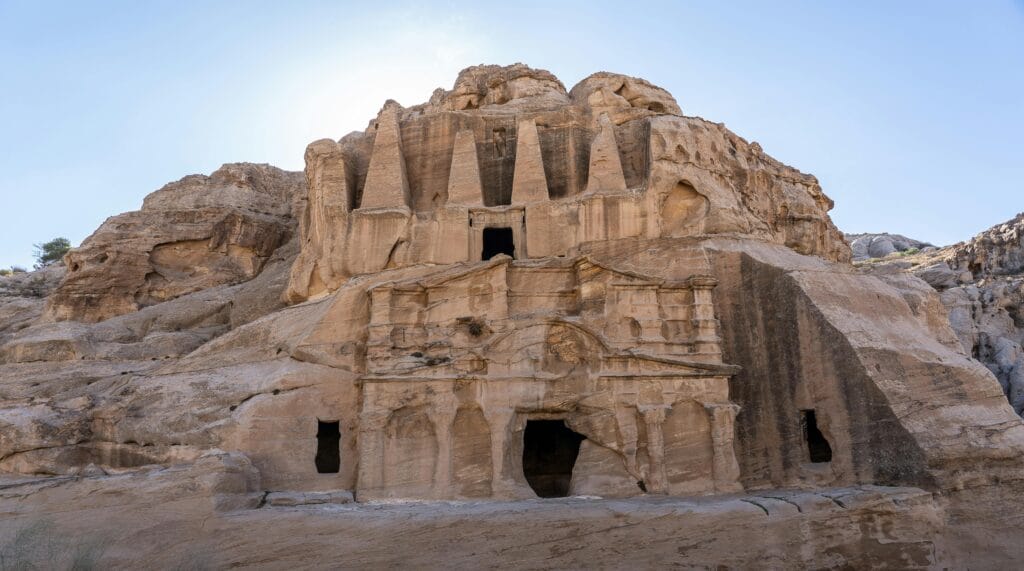
Petra is well-known for its beautiful ancient buildings and incredible historical sites carved into rock. It used to be the main city of the Nabataean Kingdom. Visitors are captivated by its impressive tombs, temples, and a clever system designed to manage water, showcasing the ingenuity of its builders.
One of the most famous sights in Petra is Al-Khazneh, often called “The Treasury.” It’s an impressive building carved right into the striking red cliffs. Petra is known for its special mix of Eastern and Western styles in architecture. That is why it has been designated as a UNESCO World Heritage site and acknowledged as one of the World’s New Seven Wonders.
Preservation of Petra
Preserving Petra is very important because of its incredible cultural, historical, and architectural value. As a UNESCO World Heritage Site, many efforts are being made to protect and care for its unique rock-carved structures that have been around for centuries. These initiatives show a strong commitment to keeping this amazing place safe for future generations, so that Petra can remain a precious part of our history.
Why should you visit Petra as a visitor?
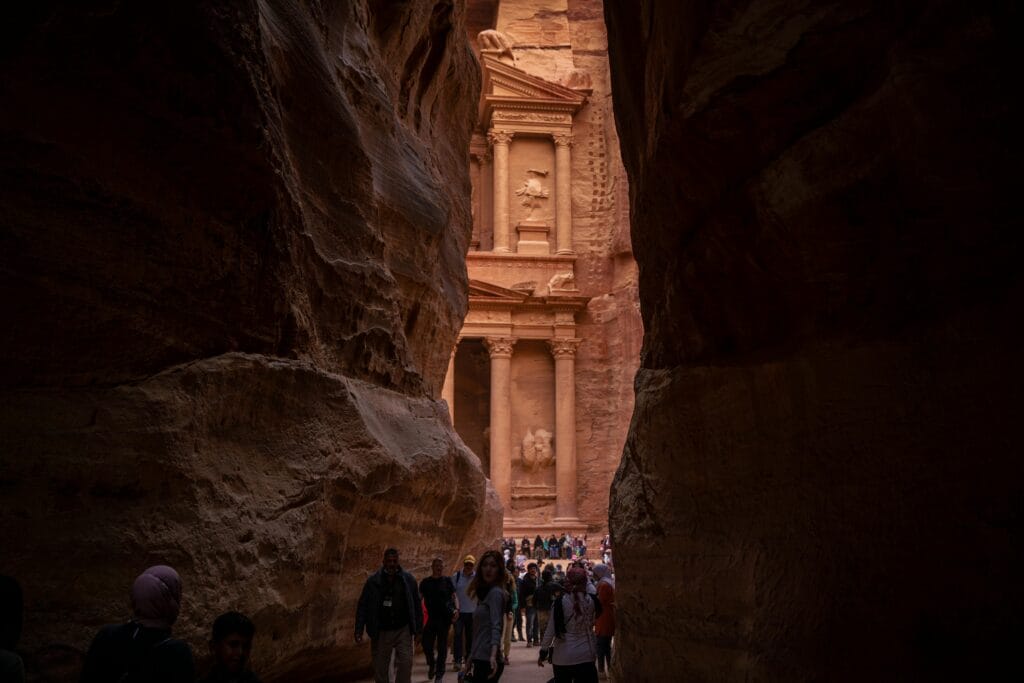
Visiting Petra is a fantastic experience that showcases incredible historical sites and beautiful landscapes. Recognized as one of the New Seven Wonders of the World, Petra features amazing buildings carved into the rock, with famous landmarks like the Treasury and the Monastery that will leave you speechless. It’s a place filled with history that everyone should see!
Petra is an amazing place where you can explore the remains of an ancient civilization called the Nabateans. The beautiful scenery around Petra also provides great opportunities for hiking and enjoying nature. Whether you’re interested in history, stunning buildings, or just want to take in some beautiful views, Petra offers a memorable experience for everyone.
Are you excited to discover the amazing sights of Petra?
Are you excited for an adventure? Get ready to visit Petra, a truly amazing and ancient place! You’ll be wowed by its stunning sights and fascinating history. Start planning your trip and prepare to explore one of the most incredible spots in the world! When you’re planning your adventure, enhance your travel experience by using trusted websites like GetYourGuide, Trip.com, Agoda, Expedia and Hotels.com! These platforms offer a variety of enjoyable tours, activities, and accommodation options to suit every traveler’s needs.
- GetYourGuide offers a wide variety of unforgettable travel experiences. You can choose from tickets to Popular Attractions, Transportation Options, City Passes, Guided Tours, Hop-on Hop-off Bus Services, Water Activities, Day trips, and Trips that last several days in many locations around the world.
- Trip.com makes it easy to combine Flights and Hotels, Trains, Car Rentals, Airport Transfers and Attractions & Tours to create the perfect travel package tailored just for you.
- Agoda offers a wide range of accommodations and travel options to suit your needs. With user-friendly search features, you can easily find the perfect Hotel, Apartment, or Villa, Flights, Activities, and Airport Transfer at competitive prices.
- Expedia to find the perfect travel deals and begin planning your next adventure with ease. Your unforgettable trip is just a click away!
- Hotels.com today to explore incredible deals and find the perfect housing for your dream trip! Your adventure starts here!
Start your journey today with these reliable travel partners and unlock the best of Petra and beyond!
Disclaimer
In this post, affiliate links are included and those links are associated with well-known travel companies such as GetYourGuide, Trip.com Agoda, Expedia and Hotels.com. If you choose to purchase or book a service using those links, we may earn a commission at no additional cost to you. We focus on recommending products and services that are helpful to you and we appreciate your support!
Conclusion
We hope you find this information helpful for your next trip. If you want to learn more, check out our other travel blog posts. We cover many topics, including amazing places to visit and helpful travel tips. Whether you’re looking for hidden gems, new cultures, or helpful advice, there’s something for everyone.
Additionally, if you enjoyed the information we shared, don’t forget to explore our other travel product reviews to make your journey even better! Please take a moment to look through our previous posts and let your sense of adventure guide you on your next journey! We wish you happy travels and look forward to sharing more with you in our next blog post!




